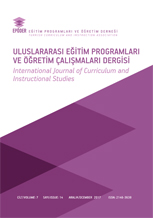Contributions of constructivist learning approach to learners’ metacognitive awareness
Abstract
The purpose of this study is to prepare and implement a hypothetical constructivist curriculum design in accordance with the assumptions of constructivist learning approach and to evaluate the design based on learners’ metacognitive awareness with regard to the traditional instructional approach. The research model of the study includes pretest-posttest control group design and qualitative data gathering procedures – a mixed research design approach. The study was conducted in the 6th grade Social Studies Course. Qualitative data include learners’ reflective journal - metacognitive thinking reports, field notes through structured observation, and interviews with the participants. Five point Likert type Metacognitive Awareness Inventory (MAI) was constructed by the researchers and used to test learners’ metacognitive awareness. “t” tests were administered to analyze quantitative sub-problems. Qualitative data set was analyzed with the inductive content analyses technique that was specifically developed by the researchers for this study. Results of the study pointed out that in constructivist curriculum design, learners’ metacognitive awareness was improved comparing with the traditional instructional approach.
Downloads
References
Bybee, R. (1997). Achieving scientific literarcy, 36. 5.2.2011 tarihinde http://www.sandiegophysics.com/5E model/Table.htm adresinden alınmıştır.
Crowther, D. T. (1997). Constructivism. Electronic Journal of Science Education, 2(2), http://www.unr.edu/homepage/jcannon/ejse/ejsev2en2ed.html.
Demirel, M. (1996). Bilgilendirici metin türünün ve okuduğunu kavrama becerisinin altıncı sınıf öğrencilerinin öğrenme düzeyine etkisi. Yayımlanmamış Doktora Tezi. Hacettepe Üniversitesi, Ankara.
Deseote, A., Roeyers H., & Buysse, A. (2001). Metacognition and mathematical problem solving in grade 3. Journal of Learning Disabilities, 34(5), 435-449.
Driscoll, M. P. (2000). Psychology of learning for instruction. Boston: Allyn & Bacon.
Dunlop, J. C., & Grabinger, R. S. (1996). Rich environment for the active learning in the higher education. In B. G. Wilson (Ed.), Constructing learning environments: Case studies in instructional design (pp.: 65-82). Englewood Cliffs, NJ: Educational Technology Publications.
Flavell, J. H. (1979). Metacognition and cognitive monitoring. American Psychologist, 34, 906-911.
Flavell, J. H. (1993). Cognitive development. (3rd ed.) Englewood Cliffs, NJ: Simon & Schuster.
Gagne, R. M., & Medsker, K. L. (1996). The conditions of learning –training applications-. USA: Harcourt Brace College Publications & Company.
Hebert, E. A. (2000). Lessons learned about student portfolios. In K. M. Cauley, F. Linder, J. H. McMillan (Eds.), Educational psychology (pp.: 218-220). Dushkin: McGraw Hill.
Honebein, P. C. (1996). Seven goals for the design of constructivist learning environments. In B. G. Wilson (Ed.), Constructing learning environments: Case studies in instructional design (pp.: 11-24). Englewood Cliffs, NJ: Educational Technology Publications.
Kuiper, R. (2002). Enhancing metacognition throught the reflective use of self-regulated learning strategies. The Journal of Continuing Education in Nursing, 33(2), 78-87.
Kurt, M. ve Karakaş, S. (2000). Sağ serabral hemisferin bilişsel işlevlerine duyarlı üç nöropsikolojik testin özellikleri ve aralarındaki ilişkiler. Psikiyatri, Psikoloji, Psikofarmakoloji (3P) Dergisi, 8(4), 251-265.
Lebow, D. (1993). Constructivist values for instructional systems design: Five principles toward a new mindset. Educational Technology Research and Development, 41(3), 4-16.
Lin, X. (2001). Designing metacognitive activities. Educational Technology Research and Development, 49(2), 23-40.
Livingston J. A. (1997) Metacognition: An overview, 30.11.2010 tarihinde http://www.gse.buffalo.edu/fas/schuell/cep564/Metacog.htm adresinden alınmıştır.
Mevarech, Z. R. (1999). Effects of metacognitive training embedded in cooperative settings on mathematical problem solving. The Journal of Educational Research, 92(4), 195-205.
Murphy, E. (1997). Constructivism. 18.4.2010 tarihinde http://www.stemnet.nf.ca/elmurphy/emurphy/constructivism.htm. adresinden alınmıştır.
O’neil, H. F. Jr., & Abedi, J. (1996). Reliability and validity of a state metacognitive inventory: Potential for alternative assessment. The Journal of Educational Research, 89, 234-245.
Patton, M. Q. (1987). How to use qualitative methods in evaluations. Newbury Park, California: Sage Publications.
Patton, M. Q. (1990). Qualitative evaluation and research methods. (2nd ed.). Newbury Park, California: Sage Publications.
Rossman, B. G., & Rallis, F. S. (1998). Learning in the field: An introduction to qualitative reseach. Thousand Oaks, California: Sage Publications.
Santrock, J. W. (2001). Educational psychology. (International Edition) New York: McGraw-Hill Companies, Inc.
Savery, J. R., & Duffy, T. M. (1996). Problem based learning: A instructional model and its constructivist framework. In B. G. Wilson (Ed.), Constructing learning environments: Case studies in instructional design (pp.: 135-148). Englewood Cliffs, NJ: Educational Technology Publications.
Schraw, G., & Graham, T. (1997). Helping giffted students develop metacognitive awerenness. Roeper Review, 20, 4-8.
Senemoğlu, N. (2009). Gelişim öğrenme ve öğretim. (14. Baskı). Ankara:Pegem A Yayıncılık.
Sternberg, R. J., & Williams, W. M. (2002). Educational psychology. Boston: Allyn & Bacon.
Ülgen, G. (1997). Eğitim psikolojisi. Ankara: Alkım Yayınevi.
Yıldırım, A. ve Şimşek, H. (1999). Sosyal bilimlerde nitel araştırma yöntemleri. Ankara: SeçkinYayınevi.





